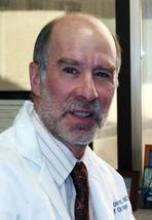Some physicians, however, may still not know. Dr. Moyer pointed out that risk communication experts recently reported that about one half (47%) of U.S. primary care physicians surveyed incorrectly said that finding more cases of cancer in screened vs. unscreened populations, "proves that screening saves lives" (Ann. Intern. Med. 2012;156:340-9).
The Push-Pull of Politics
Dr. Handel Reynolds, breast radiologist with Piedmont Hospital in Atlanta and author of the new book, "The Big Squeeze: A Social and Political History of the Controversial Mammogram," said in an interview that a series of crucial decisions made by health professionals set up screening mammography to be the controversial test it is today.
The first of these came in 1973 when, based on a single trial showing a mortality benefit in women under 50, the ACS and NCI decided to include women as young as 35 years in the National Breast Cancer Detection Demonstration Project (BCDDP), the first large-scale use of mammography as a screening tool involving some 280,000 women over 5 years (J. Natl. Cancer Inst. 1988;80:1540-7).
Just 3 years later, the National Institutes of Health (NIH) convened its first consensus conference to address screening in younger women, even though the BCDDP was not a clinical trial and demonstration projects are typically performed to show that activities with proven efficacy in clinical trials can be done on a large scale.
"1976 was the first time we had this huge blow-up about women under 50, and it has not gone away. In fact, it has become more acrimonious with each subsequent iteration," Dr. Reynolds said.
The most egregious example of political interference occurred in 1997. The NCI had broken with the ACS four years earlier and dropped its recommendation for mammography in women under 50. In 1997, however, the NCI reversed its position after a series of high-profile hearings held by then Sen. Arlen Specter (R-PA.), who chaired the subcommittee controlling funding for the NCI and who openly supported screening for women under 50, Dr. Reynolds said.
"The 1997 episode established the primacy of politics over science in the mammography debate and made it so much easier then for the 2009 controversy to be resolved in a matter of weeks," he contends.
Pap Test Changes Fly Under the Radar
Politics played a huge role in the uproar that surrounded the 2003 cervical cancer guidelines, said Dr. Alan G. Waxman, who recalled being accused of hating his mother because the 2003 guidelines he helped pen urged less frequent screening for cervical cancer.
Although the 2012 cervical screening guidelines essentially retire the annual Pap smear, Dr. Waxman said that he’s not expecting a huge backlash. Things have been relatively quiet since two separate groups released updates this March. The change between guidelines has been incremental, and women trust the science because it hasn’t gone through the permutations and "fluctuating truth" observed with the mammography data.
"With the Pap smear, the science has been pretty much in lockstep," said Dr. Waxman, president of the American Society for Colposcopy and Cervical Pathology, which partnered with the ACS and American Society for Clinical Pathology to release its guidelines in tandem with similar recommendations from the USPSTF.


